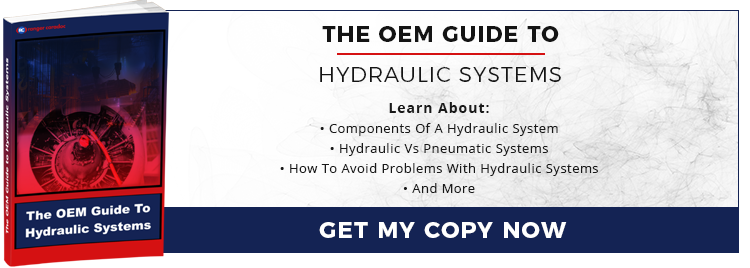
Selecting the right hydraulic pump is vital to a system’s proper function and longevity. There are numerous types of hydraulic pumps to suit different purposes. In this article we explain which pumps can work for which systems.
The most common hydraulic pump types are gear, piston, and vane. It’s always a good idea to speak to the pump provider to make sure you’ve chosen the right one for your needs.
1) Gear Pumps
Gear pumps have the simplest design of the three main types. The pump uses rotating and sequential or interlocking gears to push the fluid.
It is a fixed (also called positive) displacement pump, which means that a fixed amount of fluid is relocated with each stroke of the motor. Fixed displacement pumps produce high flow rates at low pressures.
Gear pumps have only a few moving parts, which helps them last longer. They are easy to maintain and service, and are tolerant of contamination. They also come with an appealingly reasonable price tag.
Gear pumps work well in systems that require high-pressure output. Since the output of the pump isn’t too affected by the pressure, it’s also a good choice for any project where the supply is irregular.
2) Piston Pumps
There are two types of piston pumps:
- Radial – pistons are placed in a radial position around the drive shaft. Radial piston pumps are suitable for high power applications.
- Axial - pistons are placed inside a cylinder block and driven by an angled swashplate powered by the input shaft.
Piston pumps are usually a requirement for systems with a high operating pressure (up to 1,000 bar). Compared to gear pumps, piston pumps can withstand higher pressure with comparable displacement.
On the downside, piston pumps come with a higher price tag, require stricter filtration, and have fairly complex servicing and maintenance requirements. This is because they have more moving parts than gear pumps, and a lower resistance to contamination.
Piston pumps are available with a fixed or variable displacement design. Variable displacement pumps allow the displacement to change proportionally to the change in the cycle speed or rate. By changing the input speed, it’s possible to affect the pump’s output. This isn’t possible with a fixed displacement pump.
Piston pumps are an ideal choice when it’s important to vary system flow without varying the engine speed.
3) Vane Pumps
Vane pumps have sliding rectangular vanes placed into a circular motor supported in a cycloidal cam. When vanes are compressed against the walls of the housing during rotation, they create suction. Vane pumps come in both fixed and variable designs.
These pumps have a low pressure capability (less than 140 bar), are used for systems which use low viscosity fluids, such as propane, solvents, alcohol, and refrigerants.
Vane pumps come in three different types:
- External – can handle large solids
- Flexible – creates an excellent vacuum
- Sliding – can run dry for a short time
Vane pumps are widely used in aviation engines for fuel transfer and de-icing. They are also employed in the auto industry. Vane pumps are the quietest of the three types we’ve looked at in this article.
A Quick Look At Operating Parameters
When choosing a hydraulic pump you have to identify the following operating parameters:
- Pump drive speed
- Operational temperature
- Operational hours
- Volume (required output flow)
It is important to select a pump with the right parameters for the application. Give us a call and speak with one of our technical sales team if in doubt.
Download Our Free Guide
At Ranger Caradoc, we offer a wide selection of hydraulic pump components for a range of projects. For more information, please download our free e-book, The OEM Guide To Hydraulic Systems.








